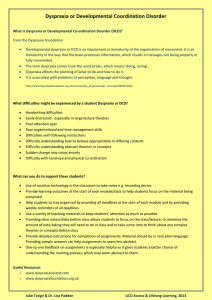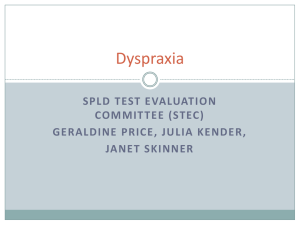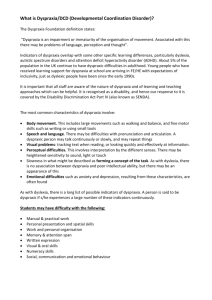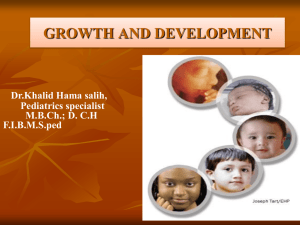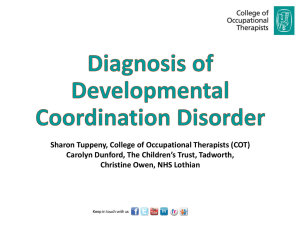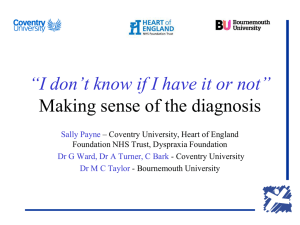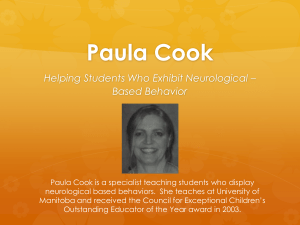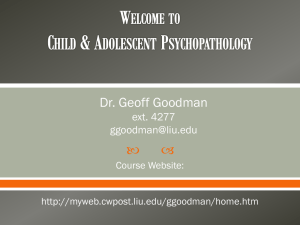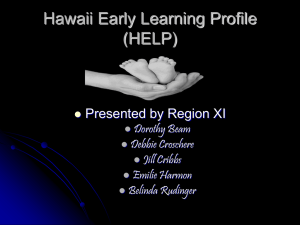What is the activity participation profile of Irish adolescents
advertisement
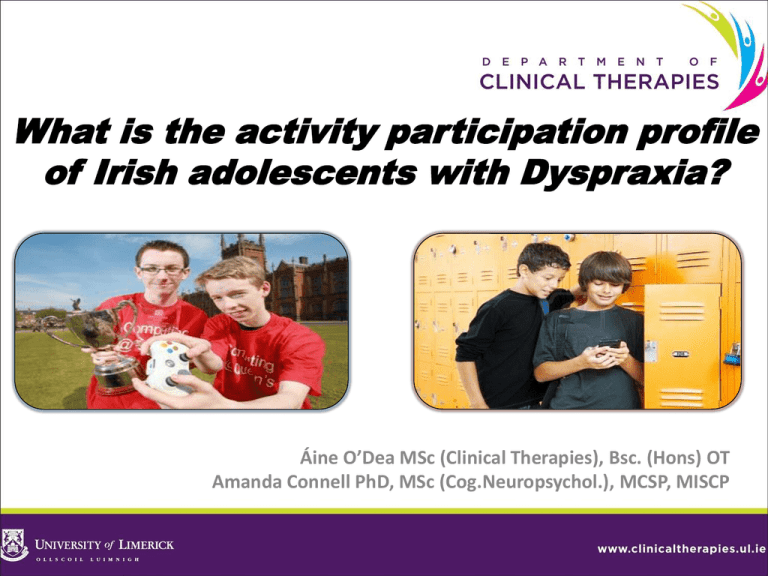
What is the activity participation profile of Irish adolescents with Dyspraxia? Áine O’Dea MSc (Clinical Therapies), Bsc. (Hons) OT Amanda Connell PhD, MSc (Cog.Neuropsychol.), MCSP, MISCP Study Aims • To examine what challenges and barriers affect participation in daily activities for Irish adolescents with Dyspraxia; using a secondary analysis methodology. • To investigate if emotional difficulties are highlighted by adolescents with Dyspraxia due to restricted participation. Objectives 1. Review the terminology of motor proficiency disorders. 2. Identify if social-environmental factors create barriers to participation? 3. Identify what daily activities are restricted and how performance skills influence participation for adolescents with Dyspraxia. 4. Determine the emotional impact of participation restrictions. 5. Highlight core health services accessed by adolescents with dyspraxia. Descriptive terminology of motor proficiency disorders • • • • Clumsy Child Syndrome Minimal Brain Dysfunction Sensory Integration Disorder Deficits in Attention, Motor Control & Perception (DAMP) • Dyspraxia • Developmental Coordination Disorder (DCD) ( DSM-IV, APA 2000; European Academy for Childhood Disability ,2012) Sugden, 2005, Leeds Consensus) Diagnostic Criteria (DSM-IV-TR 2000) A. Performance in daily activities that require motor coordination is substantially below that expected, given the person’s chronological age and measured intelligence. B. Disturbance in Criterion A significantly interferes with academic achievement or activities of daily living. C. Disturbance is not due to a general medical condition (e.g. cerebral palsy, or muscular dystrophy) and does not meet the criteria for a Pervasive Developmental Disorder. D. If mental retardation is present, the motor difficulties are in excess of those usually associated with it. DCD • DCD is a major health problem for school age children (Green et al 2011) • Internationally estimated prevalence rates: 6% -13% (Mandich et al 2001) • Incidence rates: 2:1 boys: girls • Heterogeneous presentation: Poor balance, coordination, manual dexterity & low self-esteem. (Green et al 2008; Piek et al 2006) Activity participation difficulties across the lifespan • Children do not grow out of it (Cantell et al 2003; Kirby et al 2011) • Changing profile of socio-emotional, physical, & vocational difficulties emerge with adolescence. • Executive functioning difficulties; i.e. organisation, planning and completion of complex daily tasks affect participation (de Oliveria et al 2011; Kirby et al 2011). Methodology • Design: Secondary analysis: National Physical & Sensory Disability Database (NPSDD). • Inclusion Criteria: 16-19 year olds with DCD/ Dyspraxia • Sample: N=141 Adolescents with Dyspraxia; N=< 5 Adolescents with DCD • Research Tool: NPSDD Interview form • Data Analysis: Descriptive Statistics Results Total sample: 146 participants • 5 DCD participants excluded • 141 Dyspraxia participants included MAP Section of NPSDD qualitative interview N = 40/141 • ‘barriers & challenges to participation’, • ‘participation restrictions in areas of daily living’ • ‘WHODAS II’ Data on access to services 141/141 Social-environmental barriers to participation Physical Transport Environment 18% 16% People's Services & Attitudes Supports 19% 26% Access to Information 21% Activity Participation Restrictions Education & Training: • 20% Mild; 15% Moderate Socialising: • 20% Mild; 12% Moderate Family Life: • 17% Mild; <12.5% Moderate Emotional Impact Education & Training: • 30% affected a little; < 12.5% affected a lot Socialising: • 17.5% = affected a little; 12.5% affected a lot Family Life: • 20% affected a little; <12.5% affected a lot Performance Skill Difficulties Area of Participation Restriction Mild Difficulty Moderate Severe Extreme Difficulty Difficulty Difficulty Concentration on doing something for ten minutes? 22.5% 25.0% <12.5% 15.0% Learning a new task 20.0% 27.5% <12.5% 0.0% Taking care of your household responsibilities 12.5% 20.0% <12.5% 0.0% <12.5% 15.0% 12.5% 0.0% Maintaining a friendship 12.5% 15.0% <12.5% <12.5% Your day to day work/school 20.0% <12.5% <12.5% 0.0% How much of a problem did you have in joining in community activities 25.0% <12.5% <12.5% <12.5% Dealing with people who you do not know Day Services Day Currently receiving services Requiring Services (N=110) (N=56) Mainstream primary school 20 <5 78 14 <5 <5 <5 <5 Mainstream secondary school Specialist day primary school Specialist day secondary school Third Level Education 17 Vocational Training 7 Access to Health Services Occupational Therapy Psychology 58: receiving service but 57: receiving service but 18 awaiting further 12 were awaiting enhanced Service. further enhanced service 83: not receiving any service but 45 of these 84: not receiving any adolescents were service but 36 of these awaiting an assessment adolescents were waiting an assessment Summary 1. Review terminology of motor proficiency disorders. Ireland is not yet in line with European recommendations. 2. To identify if social-environmental factors create barriers to participation? Services & supports, Access to information & People’s attitudes. 3. To identify what daily activities are restricted and how performance skills influence participation. Education & Vocational Activities → Executive functioning difficulties Socialising Activities → Difficulties maintaining a friendship & meeting new people. Summary 4. Determine the emotional impact of participation restrictions. Academic, vocational & social participation restrictions were linked to difficulties with emotional well-being. 5. To highlight what are the core health services accessed by adolescents with dyspraxia. Occupational Therapy Psychology services. Conclusion Health services are crucial to support this population group. Research involving a larger sample size, including adolescents with a diagnosis of DCD is necessary. NPSDD a valuable resource for secondary analysis research; further research into this diagnostic group with transition across the lifespan is necessary. References • Cairney, J., Hay, J. A., Faught, B.E., Mandigo, J. & Flouris, A. (2005) ‘Developmental Coordination Disorder, Self-efficacy towards physical activity and play: Does gender matter?’ Adapted Physical Activity Quarterly, 22, 6782. • Cantell, M.H., Smyth, M. M. & Ahonen, T.P. (2003) ‘Two distinct pathways for developmental coordination disorder: Persistence and resolution’, Human Movement Science, 22, 413-431. • de Oliveira, R. F. & Wann, J.P. (2011) ‘Driving skills of young adults with developmental coordination disorder: Regulating speed and coping with distraction’, Research in Developmental Disabilities, 32,1301-1308. • Health Research Board (HRB), Health Information and Evidence, National Physical and Sensory Disability Database (NPSDD) (Online) available: http://www.hrb.ie/health-information-in-house-research/disability/npsdd/ (accessed 9 April 2012). References • Hessell, S., Hocking, C., & Graham Davies, S. (2010). ‘Participation of boys with developmental coordination disorder in gymnastics’, New Zealand Journal of Occupational Therapy, 57(1), 14-21. • Kirby, A., Edwards, L. & Sugden, D. (2011) ‘Emerging adulthood in developmental coordination disorder: Parent and young adult perspectives’, Research in Developmental Disabilities, 32(4), 1351-1360. • O’Brien, J. C., Williams, H.G., Bundy, A., Lyons, J. & Mittal, A. (2008) ‘Mechanisms that underlie coordination in children with developmental coordination disorder’, Journal of Motor Behavior, 40(1), 43–61. • World Health Organisation. ‘International classification of functioning, disability and health: Short version’, Geneva: World Health Organisation; 2001.
